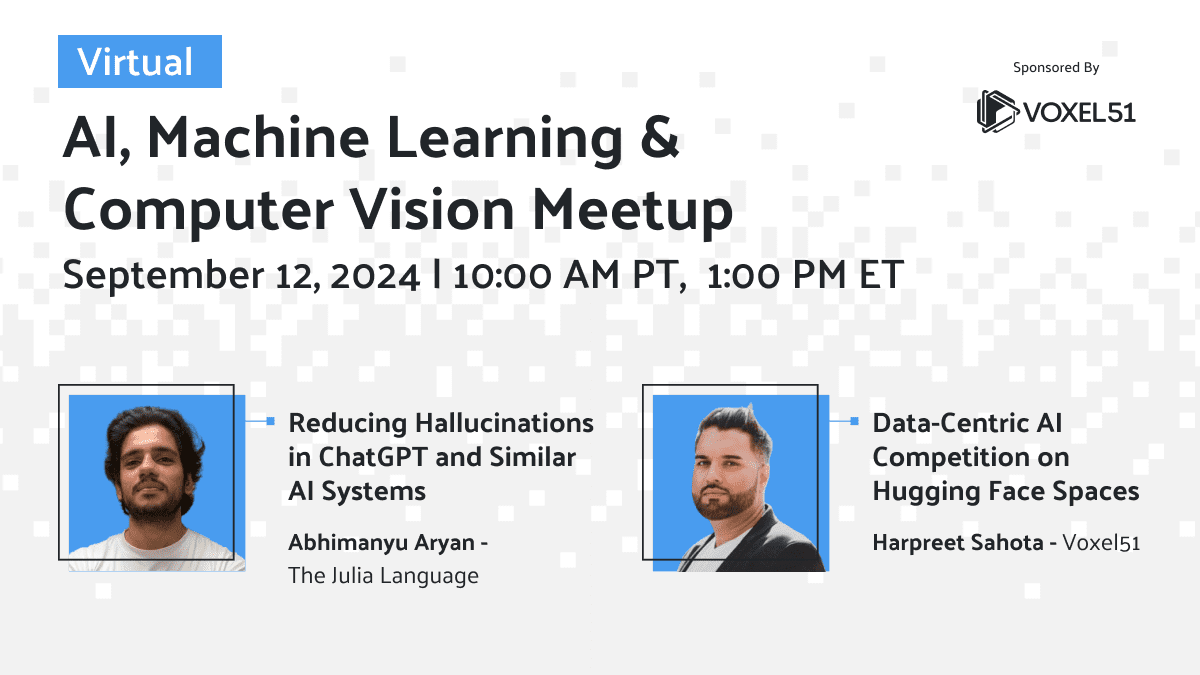We just wrapped up the August ‘24 AI, Machine Learning and Computer Vision Meetup, and if you missed it or want to revisit it, here’s a recap! In this blog post you’ll find the playback recordings, highlights from the presentations and Q&A, as well as the upcoming Meetup schedule so that you can join us at a future event.
First, Thanks for Voting for Your Favorite Charity!
In lieu of swag, we gave Meetup attendees the opportunity to help guide a $200 donation to charitable causes. The charity that received the highest number of votes this month was Heart to Heart International, an organization that ensures quality care is provided equitably in medically under-resourced communities and in disaster situations. We are sending this event’s charitable donation of $200 to Heart to Heart International on behalf of the Meetup members!
Missed the Meetup? No problem. Here are playbacks and talk abstracts from the event.
SyntStereo2Real: Edge-Aware GAN for Remote Sensing Image Translation while Maintaining Stereo Constraints
In this talk we’ll explore SyntStereo2Real, a lightweight I2I translation framework for stereo pairs considering a semantic-consistent translation of left and right images. Utilization of edge maps and an efficient warping loss are used to improve the matching of the generated pairs. This approach outperformed the current SOTA on remote sensing and autonomous driving datasets!
Speaker: Vasudha Venkatesan is a researcher and engineer with expertise in computer vision and machine learning. She has made significant contributions to the field of remote sensing, particularly addressing challenges related to stereo-matched data and domain generalization.
Resource Links
Q&A
- What are the synthetic autonomous vehicle driving datasets used in the research?
- Are these GANs used to create synthesized datasets to train another model to predict the disparity?
- In the formula, what are xb, sa, sb amongst the inputs?
- How do you get the style code from source and target domains?
- How much data is created in the synthesized dataset, compared to the original dataset?
- Did you notice any loss of details like missing foreground objects or inconsistencies between the generated left and right images when you did the KITTI translation?
Elevating Security with Data-Centric AI: A Comprehensive Approach to Surveillance
Effective machine learning models crucially depend on high-quality data inputs. The security sector, grappling with vast volumes of video data, faces the critical task of building reliable models amidst unique challenges. In this session, we dive into the how by ML engineers are leveling up by prioritizing data-centric workflows to enhance model efficacy. Join us as we unveil strategies to identify errors, analyze embeddings, and assess security models with unparalleled precision using FiftyOne.
Speaker: Daniel Gural is a seasoned Machine Learning Evangelist with a strong passion for empowering Data Scientists and ML Engineers to unlock the full potential of their data. Currently serving as a valuable member of Voxel51, he takes a leading role in efforts to bridge the gap between practitioners and the necessary tools, enabling them to achieve exceptional outcomes. Daniel’s extensive experience in teaching and developing within the ML field has fueled his commitment to democratizing high-quality AI workflows for a wider audience.
Q&A
- In regards to Ultralytics, do you think RT-DETR, which uses the Apache license, has a chance to become a deployable network for drones or is it too big/slow?
How to Develop Data Science Projects with Open Source
As a data scientist/ML practitioner, how would you feel if you can independently iterate on your data science projects without ever worrying about operational overheads like deployment or containerization? Let’s find out by walking you through a sample project that helps you do so! We’ll combine Python, AWS, Metaflow and BentoML into a template/scaffolding project with sample code to train, serve, and deploy ML models…while making it easy to swap in other ML models.
Speaker: Jay Cui had worked at BENlabs as a machine learning platform engineer. Prior to that, he was an undergraduate student studying applied mathematics with a minor in computer science at BYU.
Q&A
- Do the end points can take any type of data as an input of the model, like say continuous data streams?
- Does the template account or enable horizontal scaling?
Resource links
- GitHub: ml-service-template repo
Join the AI, Machine Learning and Computer Vision Meetup!
The goal of the Meetups is to bring together communities of data scientists, machine learning engineers, and open source enthusiasts who want to share and expand their knowledge of AI and complementary technologies.
Join one of the 12 Meetup locations closest to your timezone.
- Athens
- Austin
- Bangalore
- Boston
- Chicago
- London
- New York
- Peninsula
- San Francisco
- Seattle
- Silicon Valley
- Toronto
What’s Next?

Up next on Sept 12, 2024 at 10:00 AM PT / 1:00 PM ET , we have two great speakers lined up!
- Reducing Hallucinations in ChatGPT and Similar AI Systems- Abhimanyu Aryan, Open Source Developer at The Julia Language
- Update: Data-Centric AI Competition on Hugging Face Spaces, Harpreet Sahota, Hacker-in-residence and Machine Learning Engineer at Voxel51
Register for the Zoom here. You can find a complete schedule of upcoming Meetups on the Voxel51 Events page.
Get Involved!
There are a lot of ways to get involved in the Computer Vision Meetups. Reach out if you identify with any of these:
- You’d like to speak at an upcoming Meetup
- You have a physical meeting space in one of the Meetup locations and would like to make it available for a Meetup
- You’d like to co-organize a Meetup
- You’d like to co-sponsor a Meetup
Reach out to Meetup co-organizer Jimmy Guerrero on Meetup.com or ping me over LinkedIn to discuss how to get you plugged in.
—
These Meetups are sponsored by Voxel51, the company behind the open source FiftyOne computer vision toolset. FiftyOne enables data science teams to improve the performance of their computer vision models by helping them curate high quality datasets, evaluate models, find mistakes, visualize embeddings, and get to production faster. It’s easy to get started, in just a few minutes.

